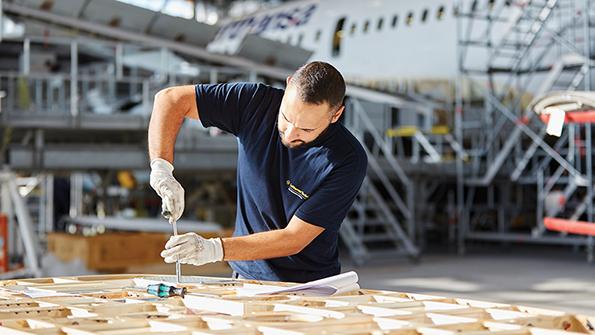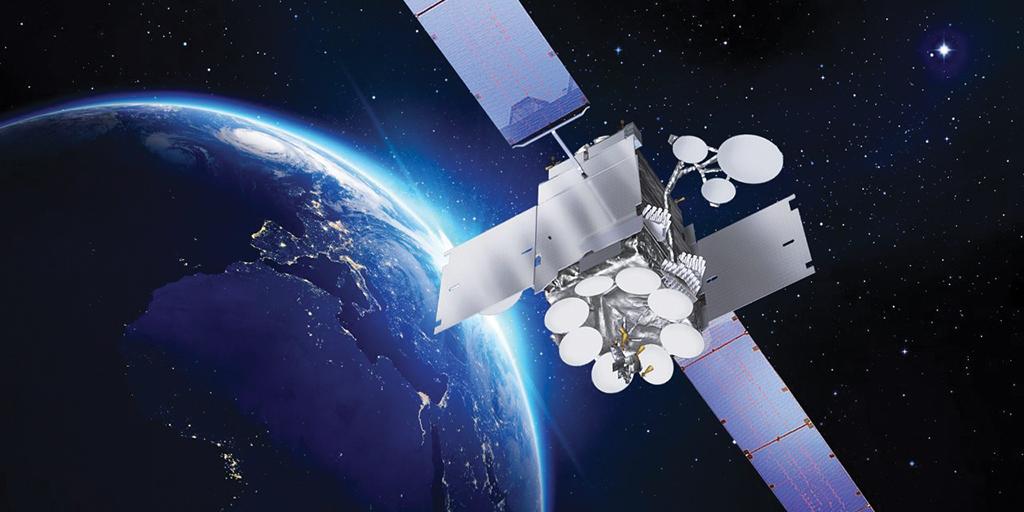Connectivity Installations Could Boost Passenger Traffic Post-Pandemic

Connectivity and air travel are set for a strange tango over the next few years, moving in tandem and opposition as airlines seek to win back passengers. For while lockdowns have further entrenched the importance of connectivity—meaning passengers are increasingly likely to desire it—the technology enabling them to work from home may reduce the need to fly at all.
Today, a little over one-third of the global airline fleet offers some form of inflight connectivity (IFC) following strong growth in installations, coverage and connection speeds in the years leading up to the coronavirus crisis. Connectivity rollout occurred primarily in the retrofit market rather than via buyer-furnished equipment on new-build aircraft, and with aircraft production and deliveries set back by mass deferrals and cancellations, that trend is set to continue.
The question then becomes whether airlines will also defer or cancel connectivity installations in a bid to conserve cash during a period of slack demand. Michael Leung, AAR’s managing director of engineering services for Asia, says this is exactly what occurred last year. Moving forward, he expects a cautious approach, with airlines implementing phased upgrades rather than committing to full-scale connectivity programs.
“Many airlines postponed or canceled connectivity upgrades in 2020 during the pandemic or delayed selection of equipment for line-fit aircraft as airlines were not certain about the future, especially before the availability of [the COVID-19] vaccine,” Leung notes.

However, with vaccine production ramping up, airlines now see light at the end of the tunnel, and some are planning to take advantage of aircraft downtime this year to refresh their cabins ahead of—they hope—some demand returning in 2022.
“There are some customers, especially the larger legacy carriers and regional operators, who have started planning ahead for the restoration of more flights and capacity in 2022 and beyond. Hence, some of these customers have started planning to implement cabin retrofit, USB power, Wi-Fi and connectivity programs toward the later part of 2021 or early 2022 with the intention to finish these retrofits before summer 2022,” Leung says.
Other elements of the connectivity value chain have an even more optimistic outlook, given the potential of inflight Wi-Fi to win back passengers who may have hygiene qualms about returning to air travel.
“It’s an essential tool that airlines can utilize to rebuild passenger confidence, establish stringent health and safety standards, and reduce passenger touchpoints throughout the journey,” says Christopher Rogerson, vice president of global sales at Inmarsat Aviation. He adds: “Encouragingly, we’ve not noticed a downturn in IFC installations in 2020 from our customers, as many leading airlines continued to roll out their inflight connectivity plans.”
One reason for this may be that connectivity providers sometimes help finance some of the costs of installations on their customers’ aircraft, says Lukas Bucher, head of product connectivity at Lufthansa Technik. As a result, the MRO provider has not experienced any outright cancellations for connectivity installations booked before the crisis, although he adds that airlines in the most serious difficulty have paused work.
“Airlines that are confident of still being in operation once the crisis fades have held on to existing contracts that are currently in execution. Since such contracts run for years, the implementation had to be adjusted as per each airline’s respective situation, but none have really been canceled,” Bucher says.
At the beginning of 2021, the market showing the fastest recovery in traffic was China, and Bucher expects a “strong need” from Chinese airlines for connectivity solutions. He notes that the EU-China Bilateral Aviation Safety Agreement (BASA), which came into force in late 2020, will speed up validation of European Union Aviation Safety Agency (EASA) connectivity supplemental type certificates (STC) in China, opening the market up further to Lufthansa Technik.
“The physical work will happen in China with local MROs,” Bucher says. “But the engineering and certification brain work will be conducted in Europe.”
Online Barometer
Among airlines that do pursue connectivity upgrades over the next 18 months, the choices they make will provide an interesting gauge of how they see air travel trends developing after the crisis.
Until now, most airlines with IFC have offered it for free in business class and as a paid service in economy. But for the next few years, business travel appears extremely vulnerable to displacement by video conferencing due to familiarization with that technology as more people work from home, along with a growing corporate focus on sustainability and the possibility of slashed travel budgets, given ongoing difficult economic conditions.
Data from the International Air Transport Association for 2019 shows that premium cabins accounted for about 5% of global passengers but 30% of revenues. Furthermore, premium traffic accounted for more than half the revenues on transatlantic flights, almost half on Europe-Middle East routes and around 40% on flights over the north Pacific and mid-Pacific and between Europe and Asia.
If a substantial chunk of this market evaporates, one could conclude that airlines would have less impetus to pursue connectivity installations. However, there is growing recognition of the importance of Wi-Fi to leisure as well as business travelers, as evidenced by more carriers, such as Delta Air Lines and JetBlue, introducing it for free in all cabins. So the technology may prove to be an essential investment for companies seeking to offset any lost business demand with leisure bookings or the expansion of premium-economy offerings.
“As the recovery kicks in, we are seeing IFC even higher on the priority list than ever before as digital transformation accelerates across the industry,” says Don Buchman, vice president and general manager of Viasat Commercial Aviation.
Connectivity may also prove to be a useful weapon in the scramble for market share that is likely to dominate a post-pandemic landscape cratered by many airline failures. “The pandemic has forced airlines to take a hard look at their current digital capabilities and how innovative connectivity solutions can give them an edge against competitors,” says Inmarsat’s Rogerson.
That view is backed up by airlines. Harri Valkama, product owner of inflight entertainment and connectivity at Finnair, notes that the carrier is aiming to increase IFC coverage on short-haul flights. “We feel that nowadays it’s more like a hygienic factor that you have IFC in the aircraft the same way as in hotels,” he says. Passengers would rather touch their own devices than seatback screens.
His views are echoed by Asif Khan, senior manager of IFE and publications at Etihad Airways. “Inflight connectivity is increasingly becoming a hygiene factor on flights, especially medium-to-long-haul legs where guests expect an onboard Wi-Fi solution to stay connected throughout their journey,” he says.
Coverage
Confident that more airlines will feel the push to adopt free inflight Wi-Fi, satellite service providers have stuck to plans to increase their coverage and capacity. One example is Inmarsat’s partnership with Hughes, which will leverage the latter’s satellites to provide Inmarsat’s GX+ broadband service to airlines in North America.
Other providers also have not let the pandemic derail their expansion plans. “We are focused on bringing ViaSat-3, our ultra-high-capacity satellite constellation—which is comprised of three GEO satellites—to market,” Buchman says. “We have not diverged from that plan; we are 100% committed to launching the three Via-Sat-3 satellites: Americas; [Europe, the Middle East and Africa; and [Asia-Pacific].”
Rival company Inmarsat saw its 14th satellite, GX5, enter service in December 2020, and it is planning seven further launches by 2024. These will include five in geostationary orbit and two in highly elliptical orbits for polar coverage. “We are very interested in the additional IFC coverage in the polar areas, as some of our flight routes go over very high latitudes,” Valkama at Finnair says.
Hardware
While satellites are a necessity for IFC during long-haul flights or those crossing seas or remote regions, many short-to-medium-haul flights over land can take advantage of ground-based transmitters. With that in mind, in October 2020 Thales, Nokia and Skyfive launched their 4G LTE system, which leverages existing 4G technology to deliver speeds of up to 100 MBps and latency of less than 50 millisec., according to Thales.
Typically, latency for ground-delivered connectivity is less than that for satellites due to the shorter distance a signal travels. In the future, though, constellations of new low-Earth-orbit (LEO) satellites could close the latency gap between ground and orbital systems while also further lowering bandwidth costs. Launches from Telesat and OneWeb are planned over the next few years, with the former company planning a 298-satellite constellation to deliver global coverage at gigabit-per-second speeds by late 2023.
However, most of the satcom antennas in use by the global fleet are not optimized for LEO communications, which may mean another round of retrofits for airlines that wish to take advantage of the new technology.
Even within existing communication networks, airlines that wish to change service providers must often invest in new onboard IFC hardware. “We would like to see more standardization of the IFC hardware provisions and equipment so that you could use different IFC service providers with the same hardware,” says Finnair’s Valkama.
Etihad’s Khan believes that the industry should aspire to “an international connectivity standard that would provide airline guests a seamless connectivity experience even between different platforms and airlines.” He adds: “Plug-and-play connectivity hardware will also benefit airlines and OEMs alike.”
At Lufthansa Technik, Bucher notes that the crisis has given the company’s engineers time to prepare for demand for new onboard connectivity hardware, such as flat-panel, phased- and steered-array antennas. Some of these are already available, such as a flat-panel ThinKom antenna designed to work with Inmarsat’s North American network, which Rogerson says will “ensure that the connectivity needs of data-hungry passengers are met for generations to come.”
Other flat-panel antennas are quickly coming onto the market, although airlines have not yet begun to adopt them in meaningful numbers. Nonetheless, Bucher believes it is wise to prepare for new technologies.
“Our engineering is working with significant hardware-developing companies and the future LEO operators to develop new solutions for airlines,” he says. “It is a good time to prepare the solutions required on an aircraft in order to make use of such new constellations once they are ready and regulatory aspects such as frequency usage and landing rights have been settled.”






Comments